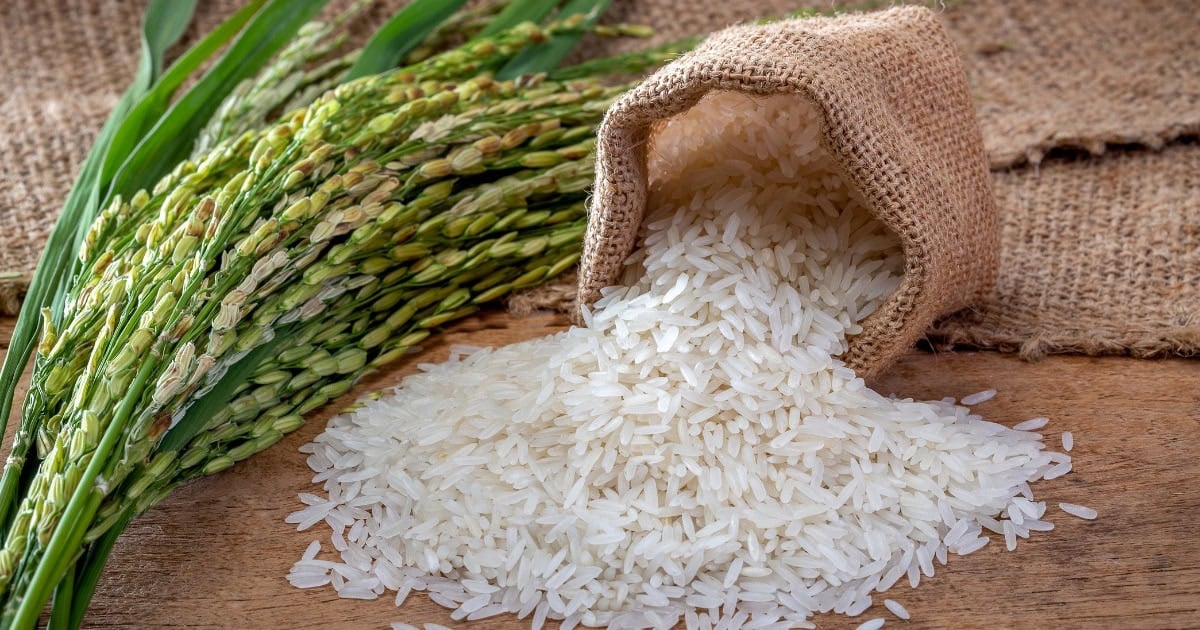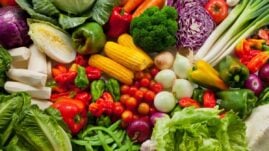This post may contain affiliate links. Please read our disclosure.
For people with diabetes, eating white rice can present an issue when it comes to managing blood sugars.
This article will explore other alternatives to white rice, as well as provide tips for how to safely fit white rice into a diabetes-friendly eating plan.

What are lower-carb alternatives to white and brown rice?
Rice is not off-limits for people with diabetes, but its high carb content means that you’ll need to watch how much you eat.
Luckily, there are several options that are lower in carbs, quite tasty, and worth trying.
Cauliflower rice
Not a fan of cauliflower? It’s still worth giving riced cauliflower (aka “cauliflower rice”) a try. Made from cauliflower florets that have been grated or finely chopped into rice-like grains, cauliflower rice is a good alternative to white rice (it also subs as a replacement for couscous).
Added bonus: It has a mild flavor and a texture that’s similar to rice, making it highly versatile.
You can make your own cauliflower rice by pulsing cauliflower florets in a food processor or grating them on a box grater until they’re broken down into rice-like granules. You can eat them raw or warm them in a skillet on the stove.
If all that sounds like too much work, head to the freezer section of your grocery store to find riced cauliflower. Look for these brands: Green Giant, Birds Eye, Cascadian Farm, Good & Gather Organic, and 365 Whole Foods Market, as well as other store brands.
Hint: Choose plain or original riced cauliflower over seasoned versions to limit fat, sodium, and added sugars.
On average, 1 cup of cauliflower rice contains about:
- 27 calories
- 5 grams of carbs
- 3 grams of protein
- 0 grams of fat
- 3 grams of fiber
Shirataki rice
Also called konjac rice, shirataki rice is made from the root of the konjac plant. This “rice” has become popular among people following keto or other low-carb diets thanks to its low carb content and calorie count.
Shirataki rice contains a starch called glucomannan, which acts like a fiber. Glucomannan can absorb substantial amounts of water, leading to the rice’s characteristic gelatinous texture and translucent appearance.
There are several benefits to including shirataki rice (you can also find shirataki noodles) in your eating plan, including:
- It’s low in carbohydrates and does not cause glucose “spikes” after eating.
- It contains a soluble fiber that can help with lowering cholesterol.
- It’s free of wheat, gluten, and egg.
- It can support gut health by acting as a prebiotic, feeding helpful bacteria in the digestive tract.
- It can improve digestion and promote regular bowel movements.
The calorie and carbohydrate content of shirataki rice can vary depending on the brand and how it’s prepared. In general, 1 cup of cooked shirataki rice contains approximately:
- 5 to 10 calories
- 1 to 3 grams of carbs
- Less than 1 gram of protein
- Less than 1 gram of fat
- 2 to 3 grams of fiber
Brands of shirataki rice include:
- Thrive Market Organic Shirataki Rice
- Miracle Rice Plant Based Rice
- It’s Skinny Rice
- Yuho Konjac Noodles (Rice Shape)
When preparing shirataki rice, drain and rinse it thoroughly under water. It’s then ready to be cooked!
Wild rice
Unlike white or brown rice, wild rice is actually a type of grass seed that is harvested from certain species of aquatic grasses that grow in waterways all over the United States. Wild rice grains are long, slender, and dark brown to black.
With a firm and nutty texture, wild rice is often served as a side dish or blended with white or brown rice to make rice pilaf. Substitute wild rice for rice or any type of grain.
Health benefits of wild rice include:
- It’s lower in calories and carbs than white and brown rice, which may help with blood sugar management.
- It’s rich in several essential vitamins and minerals, including B vitamins such as thiamin, riboflavin, niacin, and folate; magnesium; phosphorus; zinc; manganese; fiber; and protein.
- It’s low in fat.
- It’s gluten-free.
- It may help lower blood lipid (fat) and blood pressure levels, according to preliminary animal studies. More research is needed to confirm these effects in humans.
- It may help improve insulin resistance.
1 cup of cooked wild rice contains roughly:
- 166 calories
- 35 grams of carbs
- 7 grams of protein
- Less than 1 gram of fat
- 3 grams of fiber
What about using other grains in place of rice?
You might be wondering if other types of grain are better choices than white or even brown rice. Here’s a brief look at how other grains rank against rice:
Quinoa
This popular grain contains all nine essential amino acids, and it’s higher in protein and fiber than rice. However, for a cooked 1-cup serving, the calories are about the same as white rice, and the carbohydrate is just 5 grams less (roughly 36 grams vs. 41 grams).
Barley
Barley contains much more fiber than rice, and the type of fiber is a soluble fiber called beta-glucan. This fiber is helpful in lowering cholesterol.
In addition, barley is rich in phytochemicals that are thought to lower the risk of heart disease and stroke.
Of note, barley does contain gluten. This grain is a little higher in protein than rice but has about the same amount of carbohydrates per serving.
Farro
Farro is an ancient type of wheat that has a nutty flavor and chewy texture, similar to brown rice. It’s rich in protein and fiber (about 12 grams per cup!) but a 1-cup serving contains 64 grams of carbs. It also contains gluten.
Amaranth
Amaranth is a seed that is naturally gluten-free, and a good source of protein and fiber. It’s especially high in lysine, an essential amino acid, along with certain minerals such as manganese and iron.
Amaranth may help lower cholesterol levels, according to animal studies, and support digestive health. One cup cooked contains roughly 46 grams of carbs, about the same as rice, and 5 grams of fiber.
All these grains may be helpful in lowering the risk of heart disease, stroke, and some types of cancer, as well as promoting digestive health. Their fiber may play a role in managing diabetes, as well, but they contain about the same amount of carbohydrates as rice.
White rice challenges
Approximately 90 percent to 95 percent of the total calories in white rice come from carbohydrates. A much smaller percentage of calories come from protein and even less from fat. During digestion, all the starch in rice is broken down into glucose, which can contribute to rapid increases in blood sugar levels.
There are many varieties of rice, and they differ based on grain size, shape, and color, as well as cooking properties and regional origins. Here are a few of the most common white rice varieties, along with their nutrition information, based on a 1-cup serving, cooked:
Long-grain white rice (e.g., Uncle Ben’s, Carolina)
- 194 calories
- 41 grams of carbs
- 5 grams of protein
- Less than 1 gram of fat
- 1 gram of fiber
Medium-grain rice (e.g., Arborio, Valencia, Bomba)
- 242 calories
- 53 grams of carbs
- 4 grams of protein
- Less than 1 gram of fat
- Less than 1 gram of fiber
Short-grain white rice (e.g., sushi rice)
- 167 calories
- 37 grams of carbs
- 4 grams of protein
- Less than 1 gram of fat
- 2 grams of fiber
Due to its high carbohydrate content and lack of bran and germ layers — removed during processing — white rice has a higher glycemic index (GI) compared to brown rice. This means it is more likely to cause quicker rises in blood sugar, making it a less ideal choice for those managing diabetes.
Is brown rice a better choice than white rice?
Brown rice, like white rice, is a carbohydrate, but it’s generally considered to be healthier than white rice for several reasons:
- Whole grain: Brown rice is a whole grain, meaning all parts of the grain — bran, germ, and endosperm — are intact. These parts of the grain provide fiber, vitamins, minerals, and phytochemicals that are essential for health. White rice, on the other hand, is processed to remove the bran and germ layers.
- Higher in fiber: Brown rice has more fiber than white rice. One cup of cooked brown rice has about 3 grams of fiber.
- More nutrients: Brown rice is richer in essential nutrients compared to white rice. For example, it contains approximately 150 percent more magnesium, 117 percent more phosphorus, and 76 percent more potassium.
- Lower glycemic index: Brown rice has a GI of roughly 55, while white rice has a GI of about 64, or even higher. However, the GI of any carb can vary due to many factors, such as how it’s processed and cooked, as well as the fat and acid content of a meal.
Carb-wise, though, brown rice has about the same amount as white rice. One cup of cooked brown rice contains roughly:
- 228 calories
- 49 grams of carbs
- 5 grams protein
- 1 gram of fat
- 3 grams of fiber
Brown rice can be a better choice than white rice, as it’s a whole grain and has a somewhat higher fiber and protein content. However, because of its high carb content, you’ll need to monitor your portions.
Can you eat rice if you have diabetes?
If you’re having a hard time letting go of rice in your eating plan, rest assured you don’t have to give it up completely. Consider trying the lower-carb options above, and when you want to include rice in your meals, try these suggestions:
- Go for whole-grain rice, such as wild rice, brown rice, or even black rice, an ancient rice that is part of Asian cuisine and used in traditional Chinese medicine. Black rice is higher in fiber, protein, and phytochemicals than white rice, which may help with blood sugar management.
- Keep an eye on portions. Aim for between 1/2 to 1 cup, at most, for meals. Check with a registered dietitian nutritionist (RD/RDN) for guidance on portion goals that are best suited to you.
- Pair rice with protein and high-fiber foods, such as vegetables, to help slow down the absorption of the carbs in the rice and prevent rapid spikes in blood sugar levels.
- Cook rice ahead of time, cool and refrigerate, then reheat it before eating. Rice prepared in this way contains resistant starch, a type of starch that “resists” digestion and behaves more like fiber. Resistant starch can help with managing blood sugars.
- Monitor your blood sugar before and after meals to learn how different types and amounts of rice affect your glucose levels.
Advice on rice in your diabetes management plan
Rice is a staple of many diets across the globe. In some households, rice is eaten several times a day.
Because this grain is a source of carbohydrates, people with diabetes may find it challenging to fit rice into their eating plans. Fortunately, there are alternatives that are much lower in carbohydrates and calories than rice, and it may be worthwhile giving some of these a try.
If you choose to eat rice, go for whole-grain varieties, limit your portions, and include sources of protein and fiber in your meals to help offset any increase in blood sugar levels.
Explore some of the delicious low-carb recipes in our Recipe Index. Did you find this article helpful? Click Yes or No below to let us know!






K
Great info! Being Asian, rice is a very large part of our diet. I’ve had to learn to do without, most of the time. I reserve rice eating for sushi on a special occasion. I do eat basmati rice though. I found it’s got minimal impact on my blood sugars. It has a different makeup than regular rice and is much lower on the glycemic index than other rice varieties.
Robert Null
Have you tried hearts of palm rice and pasta? If so, thoughts on taste and carbs.
Christel Oerum
Haven’t tried the rice but did try the pasta. You can find my full low carb pasta review here https://diabetesstrong.com/low-carb-pasta-review/
Jeff
I wanted to take the time to thank you for what you do. There are sooo many unanswered questions out there, and you answer a lot of them. I have recently been diagnosed with type 2 diabetes. I have cut my food intake way down, and I am paying much more attention to carbs and such. One of the most troubling things is total carbs vs net carbs. A lot of doctors say to only go by total carbs, especially if you are type 2. Thank you!
Christel Oerum
You’re welcome, I’m glad it’s helpful
diana irie
To remove the fishy smell from Shirataki/Konjac items, after rinsing, I soak them in water with a spoonful or two of lemon juice or white vinegar.
Christel Oerum
Thank you for the tip
roddy6667
I did a search of carb count for mung bean noodles and got very different answers. Most show 40 gms of carbs per one cup serving.
Christel Oerum
Thank you for bringing that to our attention. It should have said 1/2 cup has 21 grams of carbs. When you look at the packaging it lists a serving as 2 oz. (56 grams) which is roughly 1/2 cup
Stacy Gomes
Well Described. Eating low-carb food is really helpful for maintaining your health. Nice Article.
Dave Riley
Corn Tortillas (from Masa Harina) –esp home made — are low carb . Not as low as cauliflower, but low for grain foods.
Worth it to monitor your blood sugars after a 2 taco feast … and 2 will fill you.
Low GI too.